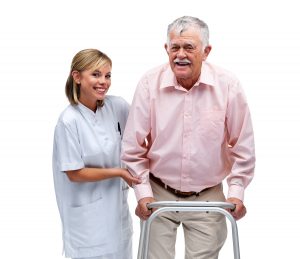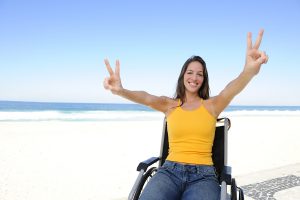Dr. Mauk’s Boomer Blog
Each week, Dr. Kristen Mauk shares thoughts relevant to Baby Boomers that are aimed to educate and amuse.
Dr. Kristen L. Mauk, PhD, DNP, RN, CRRN, GCNS-BC, GNP-BC, FAAN

Simple ways to make a bathroom fall proof

The NIH Senior Health reports that one in three people over the age of 65 experience a fall each year. Because of the non-porous, easy clean surfaces, more than 80% of these falls happen in the bathroom. The proper equipment will help to keep everyone safer. Be sure to check your loved one’s for the following:
Grab Bars. One of the simplest solutions to preventing bathroom falls is to install grab bars. Choose bars that have a grip-like surface and contrast to the color of the shower, so they are easily visible. Anchor these bars to the studs behind the wall for the best support. Have your loved one step into the tub and show you where the best place to install a safety bar is located. Adding a grab bar next to the toilet is another simple way to prevent falls.
Non-Skid Surfaces. Placing a non-skid floor mat in front of the shower and sink soaks up excess water and prevents slips. Adding a non-skid shower mat to the bathtub will prevent your loved one from sliding on the slippery tub surface when bathing. For additional safety, place non-skid adhesive strips around the sink and vanity area.
Raised Toilet Seat. Adding a raised toilet seat prevents your loved one from losing her balance and falling while trying to sit on the toilet or get up. It is also helpful for those who are losing strength.
Lighting. Many seniors lose depth perception, having brighter lighting will help your senior to judge distances better, such as stepping into the bathtub. Adding motion lights on the path to the bathroom, as well as in the bathroom, will help your loved one to see where she is walking. Having plenty of lighting will help your loved one to locate toiletry items quicker and easier as well.
Declutter. Because many older people end up needing to use a walker or cane, it is important to make sure walking paths are clean and clutter-free. It is important to keep items such as towels off the floor and out of the way as much as possible. The less items your loved one can get hooked on, the safer the home will be.
Preventing a fall from happening is ideal. However, there are times when accidents happen. Consider getting your loved one a medical alert system as an additional layer of safety. The best systems offer waterproof pendants, so they can be worn while bathing. If your loved one does fall, she can press the button and get help immediately, which may save her life.
Guest Blog: 8 Tips for Boomers to Use Screen Time Effectively
In this fast-paced digital world, technology is making a great impact on humans. They feel the compulsion to stay connected to their mobile phones or other devices. It has become a grave addiction that goes unnoticed and leads to serious health problems and issues.
You need to monitor your screen time and utilize technology constructively. Following are some of the tips on how you can use screen time effectively.
1. Stem Classes
For boomers or people who are new to technology and are unaware of how to use it efficiently, they can join stem classes that offer knowledge about four disciplines including technology. Taking stem classes enables you to think creatively and critically thus teaching you the art of self-management. Stem classes will prove to be very beneficial in the long run as you are living in a world of technology.
2. Make a Time Framework
You should be well aware of how to manage time effectively. Make a timetable and an action plan then act out on it accordingly. You have to set parameters at what times you will be using your mobile phone and for what purpose. Suppose if you have studied for 3 hours then spare screen time of about forty minutes to yourself. Set a time when you will be getting back to your emails. If you just reply to your text messages or emails the moment you receive them, then you will not have an organized routine. This will distract you from focusing on the task you are currently doing.
3. E-Learning
Technology can aid you in learning in a better way. Some people are better adapted to this type of learning. They learn best by kinesthetic modes. Install some learning and educational apps on your mobile phones. This can save you from wasting time on social media and lead to better learning strategies. You will turn out to be more productive and knowledgeable. Learn to utilize the resources wisely to be successful in life.
4. Stop Procrastinating
The act of delaying your tasks is not a professional thing to do. Procrastination needs to be cut down to enable you in thinking constructively about a subject matter. Do not just keep on scrolling through your social networking sites but instead make use of it in a good manner. Go through some informative articles related to your subject or you can even read them for your knowledge and experience.
5. Limiting Screen Time
An app called Family Safety allows managing screen time productively. You can set time limits to the apps you want to use less. You can switch to Focus Mode on your phones that turn off your social networking apps and you do not receive any notifications until the mode is switched on.
6. Avoid Multitasking
If you try to complete multiple tasks simultaneously, thinking this would save up time, don’t do it. This will lead to information overload. You will not be able to even complete a single task with good results. Try focusing on one task at a time as every task requires critical or creative thinking. Thus, this will aid in using the screen time effectively.
7. Block Ads
Ads can be a real nuisance at times. You will be researching your thesis and random ads would pop up n your window, prompting you to click on them. These advertisements are nothing but a distraction. They might look tempting but they will just take you to another window and waste your time or you will even end up bringing the virus to your computer or mobile. Thus, you should install some ad-blocking app or software that will help you concentrate.
8. Brainstorming Session
Before beginning any task, it is preferable to do brainstorming. For instance, keep in mind what is your task and goal that you want to achieve. You should have a goal in your mind only then will you be able to achieve something. As the saying goes, “an empty mind has an evil in it”, so sitting idle scrolling through the screen would not help. Stay focused and involved in your task. You should be clear about what you have to do.
Guest Blog: 5 Helpful Tips to Get Better Sleep at Night for Older People
A good night’s sleep is a cure for many physical and emotional ailments for everyone. It is vital for older people also to get deep sleep for 7-8 hours every night. They fell asleep early but wake up early too. As you get older, you generally start suffering from some illness, side effects of medicines, pain, or insomnia. These factors contribute to sleeplessness at night and waking up early. Lack of sleep can cause serious issues like depression, irritation, concentration loss, and memory loss.
Canadian Sleep Society surveyed senior citizens – they found out that 70% of older people face insomnia. Looking at the magnitude of this problem, we bring you 5 helpful tips to sleep better at night.
- Create an Environment for Sleep
It’s all about how you create the right sleeping environment. There are a few things that will make your bedroom more cosy and comforting. Switch off maximum lights. Keep the room temperature to a lower level. Keep your surroundings as quiet as possible. Sound, bright light, and warm temperature hampers sleep quality.
Don’t try to stay awake because you want to watch a game or party. These habits can prove to be costly. Don’t rely on sleeping pills for sleeping. And no scrolling or checking notifications on the phone before an hour of bedtime.
- Let’s Talk About Fabric
The fabric you surround yourself with while sleeping plays a vital role in your sleep quality. Wear loose nightclothes. Use fabric like cotton and other skin-friendly fabrics. You should feel comfortable while sleeping. The fabric of bed sheets and pillows should also be of natural materials that don’t irritate you.
Some of the wise choices are copper bed sheets and pillowcases. They are soft and contain antimicrobial properties. They are hygienic and safe as they are anti-bacterial, anti-fungal, anti-odour, etc. One more advantage of using copper-bedding and pillows is that they come with a self-cleaning feature.
- The Golden Health Rule: Diet & Exercise
A diet high in sugar and carbs will hamper your sleep, mostly if you eat them for dinner. White bread, rice, and pasta should ideally not be on your plate. Caffeine is also not a sleep-friendly drink. Avoid caffeinated beverages in the evening times.
Exercise regularly! It produces chemicals and hormones in your body, which induces sleep. But make sure you exercise at least 3-4 hours before your bedtime. Otherwise rise in your body temperature will make it difficult to sleep.
- Follow One Schedules
Going to bed at the same time and in the same place helps to fall asleep quickly. Changing sleep timing frequently sends confusing signals to your body. Making some good habits as your pre-sleep routine will enhance your sleep quality.
Reading and listening to music are examples of relaxing things to do before going to sleep. On the other hand, watching TV, drinking alcohol, and heated arguments before bedtime will mess up your ability to fall asleep.
- Preserve Your Peace of Mind
It is naturally challenging to fall asleep if you are stressed or feeling anxious. Thus it would help if you learned to manage your emotions well. Worrying about sleep will only keep you awake at night. Develop the ability to keep all your disturbing thoughts aside before bedtime. Try breathing exercises and meditation.
Conclusion
The tips mentioned above are proven for improving sleep quality. Try implementing them if you are facing a problem falling asleep. If you can’t see improvement, consult your trusted physician. They can help you if you have insomnia or any other health condition.
Author Bio:
Rory is the R&D Director and passionate entrepreneur, fascinated by the workings of the human body and natural solutions for common health problems. He’s single-minded in his aim to make Copper Defence a brand that’s recognized across the globe, by partnering with global brands to make these high-tech materials easily accessible for everyone. If you’d like to get in touch, email Rory at Rory@copperclothing.com or visit copperclothing.com for copper-infused clothing, pet accessories and more.
Caregivers Inspire You to Live Life to the Fullest
“Live life to the fullest.” How often do baby boomers encounter this phrase, when planning for their future! After all, everyone deserves only the best during retirement.
And, more likely than not, life during the golden years may also mean spending time with a caregiver. With approximately 43.5 million individuals (both informal and formal caregivers) looking after someone during retirement, it may be expected that a boomer will always have someone to watch and be with him or her most of the time.
But should this be of any concern for a boomer with dreams to achieve during the golden years? Should caregivers be seen as a person who’ll deter a retiree’s plans? No – which is why we’re listing several reasons why caregivers can actually help a boomer live life to the fullest.
A Companion Through Thick and Thin
Social isolation, a rising phenomenon among boomers today, may what some may consider as a “hidden terror” during the retirement years. A TIME article published last year, Baby Boomers Are Isolating Themselves as They Age, mentioned that more older adults are less likely to engage in community activities and meaningful interactions. As a result, a boomer’s health is placed at risk, with depression and anxiety as the leading repercussions of social isolation.
A caregiver’s presence may bring some much-needed light in some of the darkest moments of a boomer’s life. More than the custodial services and tasks they provide, their companionship provides a sense of meaning and importance for boomers. Sometimes, all it takes to make life worth living is knowing that someone is there for you, even in the most painful and dreadful times.
Offering A Fresh Perspective
Caregivers also provide boomers a fresh, exciting, and even beneficial take on everything current in the world. From being someone to talk to about the latest news to an advisor on how to understand various retirement concepts (such as long term care insurance and Medicare supplements, among others), a caregiver can help retirees get and stay in the loop with all the changes happening in the world.
Thank Your Caregiver Today
Unsung heroes: probably a good way to describe caregivers. Make sure to thank your companion today. Your retirement wouldn’t be that enjoyable without them! Also, consider purchasing insurance coverage for your golden years. Not only will you secure your health and wealth needs with insurance policies, but you may also lessen the stress caregivers face in their daily tasks of being there for you. You can jumpstart your retirement security by requesting for Medicare Supplement Quotes from FreeMedSuppQuotes today.
About the Author
Leandro Mueller
As the Online Content Director of FreeMedSuppQuotes.com, Leandro Mueller aims to push for awareness and promotion of the many benefits of Medigap plans. He plans to accomplish this through writing informative and compelling content, which is to be posted on several avenues online. Leandro hopes to push the envelope when it comes to explaining the many details one needs to tackle with Medicare Supplement Plans.
How Treatment for Prostate Cancer Reached the Radiation Stage over the Past 20 Years
It was in 1853, when a surgeon J. Adams, working at The London Hospital diagnosed prostate cancer for the 1st time. The disease was discovered during a histological examination and Adams described it as “a very rare disease”. Today, 165 years later, this disease has progressed quite rapidly and is considered as one of the most severe health problems.
Why is there such an increase in the number of people afflicted with this disease?
There are three reasons behind, which include:
• First, in the early years until the 1900s, after the disease was discovered, there was no special diagnosis technique that could differentiate urinary obstruction from prostate cancer
• Second, this cancer increases rapidly with age, as compared to other types of cancer
• Third, it is believed that prostate cancer is linked with the “Western” lifestyle. While the main causes of prostate cancer are age, family history and ethnic group, research suggests that obesity and a diet rich in calcium can also contribute to this disease
Here’s a timeline of how prostate cancer treatment reached radiation therapy:
In the early years, it took a long time to diagnose patients with cancer. By the time a treatment plan was created, the disease would take a dangerous turn and the patient would die within 1 to 2 years.
Androgen-Ablation Therapy
It was in 1786, when the Androgen-Ablation Therapy was discovered. However, it wasn’t until 1940 that this technique was used to treat prostate cancer. This therapy involved oral estrogen and medical castration to treat the cancer. While this therapy did reduce the size of the prostate, it didn’t provide any help with benign prostatic hyperplasia. Over the next 40 years, different hormone therapies were tried and a few were deemed successful. To this day, Androgen-Ablation Therapy is considered the best prostate cancer treatment.
Prostatectomy
During this time, other treatment options were in trial and in 1904; Prostatectomy emerged as a clear winner. This treatment involved removing the cancerous or all parts of the prostate gland to cut the disease from the root. There were several improvements in this therapy but almost all patients refused this treatment because it left them impotent.
Radiation therapy
Radiation therapy for prostate cancer took the stage in the early 20s. People were a bit skeptical about the treatment but when rapid advancements were made in the technology, they became more open to the treatment. Moreover, the therapy gave people the option to go for it during surgery or after surgery.
• X-ray Therapy
This therapy involves megavoltage and high-energy X-rays that penetrate the cancerous cells more deeply, which helps minimize the area of skin exposed to radiation. Doctors also used Imaging, so that they could specify the affected area and direct the radiation beams there.
• Proton Therapy
This radiation beam is more precise and doctors are able to control the depth of the beam penetrating the body. The proton therapy prevented “exit radiation”, which made a single radiation dose more powerful.
• Stereotactic Ablative Radiation Therapy
This therapy allows surgeons to target small and specific areas with a high dose of radiation. It allows them to use radiation during complicated surgeries.
There is still much room to experiment with radiation therapy for prostate cancer. New technology is being tested and people with no hopes are being admitted into trials, to find out if they have a chance to beat this disease or not.
Guest Blog: How to Choose the Perfect Wheelchair Cushion?
Let’s face it: There’s no one size for all when it comes to wheelchair cushions.
Therefore, it’s risky buying a wheelchair cushion without pre-evaluation since this might result in serious injuries. Wait a minute? Is it that important getting the right wheelchair cushion?
Prolonged wheelchair usage can result in a variety of infections, pressure points pains, and muscle misalignment such as shoulder tendon tears. According to a research published by the Agency for Healthcare Research and Quality (AHRQ), over 2.5 million people in wheelchairs in the United States, develop pressure ulcers, which are one out of many defects faced.
Therefore, to help you make the right choice, we’ve prepared the features and specifics that you need to look for when choosing the right wheelchair cushion. Without much ado, follow us on this immersive journey.
Factors to Consider Before Selecting a Wheelchair Cushion
As mentioned earlier, there’s no “all for one” type of cushion. Rather, you have to find the one that suits you or your patients’ needs. So, consider the needs before choosing a cushion:
Weight: The weight of the user is an important factor to consider. The right cushion must support the weight capacity of the user without losing its shape.
Height: consider the height of your patient before choosing a cushion. Ensure that the cushion is not so thick that the user’s feet doesn’t touch the ground.
Mobility: know the extent of the patient’s use of the wheelchair. Whether the user will sit for prolonged periods or move in and out of the wheelchair periodically, it’s vital to take this into consideration.
Skin condition: skin conditions also have an underlying role in the type of cushion to choose. Consider the skin condition of the user before choosing a cushion.
This settled, let’s explore the specifics you need to look for in wheelchair cushions.
Related Information – wheelchairs in singapore
What to Look For In Wheelchair Cushions
Select the Right Cushion Material
There are a myriad of cushion materials available for wheelchair users – air cells, foams, gels, and even hybrid combinations. To avoid health complications and discomfort, you need to select the right cushion material based on the aforementioned factors.
For instance, lightweight, spongy cushions are great to reduce the strain on the pressure points. More so, they are ideal for those without skin conditions. Since this type of cushion material come in various shapes and sizes, users can pick which suits their needs.
Latex foam wheelchair cushions, on the other hand, have an elastic build that allows it to mold to the user’s body. Since this material doesn’t absorb moisture, it’s resistant to mildew, bacteria presence, and mold. No doubt, latex foam cushions are great for those with a mild inability to retain bodily fluids.
Memory foam cushions offer optimum comfort to users with a higher risk of getting pressure injuries. Just as the name implies, it molds perfectly to your body shape. More so, it can retain its depressed shape longer, thereby, relieving the pain on your pressure points.
Gel Cushions. These type of cushions are produced from plastic polymers which mimic the protective fatty tissues of the buttocks. Patients with sensitive skin conditions will be most comfortable with this TPE type of cushion. With gel cushion, there’s minimal friction between the user’s skin and the cushion surface. In addition to this, gel cushion comes in various forms such as checkered board surface or honeycomb surface.
Although a bit higher priced than the rest, Air-filled Cellular cushions are a great option for those who desire optimum pressure pain relief. What’s interesting about this device is that users can control and monitor the amount of air that goes into the device. Due to this function, wheelchair users can correct their postures, and at the same, prevent pressure points.
Lastly, the Honeycomb cushion, with its specially crafted spongy surface, is fast becoming popular. Manufactured from Thermoplastic urethane (TPU), this device is ideal for users with pressure management needs. Just like a honeycomb, it constitutes of several small cells arranged in a beehive manner. Not only does this evenly distribute weight, but it also supports the user’s weight without losing memory. Unlike air-filled cushions, this doesn’t transfer pressure point from one side of the cushion to other areas.
Cushion Format
Irrespective of your cushion material, the cushion format is also an important feature to consider. So, talk to your rehab specialist or doctor on the best cushion format for your wheelchair. From the saddle cushion, which helps to keep your knees together to the waffle-shaped cushion which protects your skin and allows air to flow freely, there’s no end to your options as a wheelchair user.
Wrapping Up
Finally! As you can see, choosing the right wheelchair cushion is no small feat. Therefore, consider the aforementioned features and get optimum relief from wheelchair-associated infections and conditions.
Also read about 5 Pieces of Technology Seniors Need







